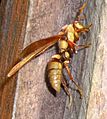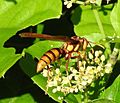Polistes carnifex facts for kids
Polistes carnifex, also known as the executioner wasp, is a very large and interesting type of wasp found in Central and South America. It's famous for having one of the most painful stings of any insect! This wasp is part of a big family of wasps called Polistes, which are known as paper wasps because they build their nests out of a paper-like material.
Contents
What is the Executioner Wasp?
The executioner wasp is a type of paper wasp. It gets its common name, "executioner wasp," because of its incredibly painful sting. These wasps are native to the warm, tropical regions of Central and South America. They are quite large, often growing to about 3 centimeters (1.2 inches) long.
Appearance
Polistes carnifex wasps have a striking appearance. They are mostly a mix of yellow and brown colors. Their bodies are long and slender, with distinct yellow and brown bands. Like all wasps, they have two pairs of wings and six legs. Their antennae are also quite noticeable.
Where They Live
These wasps are found in many countries across Central and South America. This includes places like Mexico, Belize, Brazil, and other tropical areas. They prefer warm, humid climates where they can find plenty of food and suitable places to build their nests.
Nests and Colonies
Executioner wasps are social insects, meaning they live together in groups called colonies. However, their colonies are usually quite small compared to other social insects like honey bees.
Building Nests
Polistes carnifex wasps are known as paper wasps because they build their nests out of a material that looks like paper. They create this material by chewing wood fibers and mixing them with their saliva. The nests are often shaped like an upside-down umbrella or a bowl.
They typically build their nests in sheltered spots. You might find them under the eaves of buildings, which are the parts of the roof that hang over the walls. They also build nests suspended from branches of trees or shrubs. These locations help protect the nest from rain and predators.
Life in the Colony
A typical executioner wasp colony is led by a queen. The queen is responsible for laying all the eggs. The other wasps in the colony are workers, and they help build and maintain the nest, find food, and protect the colony. Even though their colonies are small, they work together very efficiently.
Diet and Behavior
Like many wasps, Polistes carnifex plays an important role in its ecosystem. They are both predators and pollinators.
What They Eat
Adult executioner wasps mainly feed on nectar from flowers. This makes them pollinators, helping plants reproduce by carrying pollen from one flower to another. They also drink sap from trees.
However, when they are feeding their young, they become predators. The adult wasps hunt and capture other insects, like caterpillars. They chew up these insects and feed the protein-rich paste to their larvae (baby wasps) growing inside the nest. This helps control populations of other insects.
Their Famous Sting
The sting of the Polistes carnifex is widely considered one of the most painful insect stings in the world. Scientists who have experienced it describe the pain as intense, throbbing, and long-lasting. It's often compared to being burned or experiencing extreme electric shock.
The purpose of such a powerful sting is defense. It helps the wasp protect itself and its colony from predators or anything it perceives as a threat. While their sting is very painful, these wasps are generally not aggressive unless their nest is disturbed or they feel threatened. It's always best to observe them from a safe distance.
Images for kids
-
Polistes carnifex nest collected in Brazil in 1967 by William Donald Hamilton and stored at the Natural History Museum, London
See also
 In Spanish: Avispa ejecutora para niños
In Spanish: Avispa ejecutora para niños





